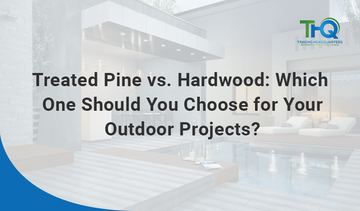Selecting timber for external projects must ideally revolve around treated pine and hardwood, two very popular options. Both materials have unique advantages, often shifting the focus back onto your project's needs, budget, and long-term maintenance. At THQ, we understand the importance of choosing the right timber, and in this blog, we will carry out a comparative study on treated pine and hardwood across several factors to help you make an informed decision
1. Understanding Treated Pine and Hardwood
Treated Pine: Pine is a softwood used for outdoor construction. Treated using pressure to increase its resistance to attacks by pests, decay, and weathering. The common aspect of treatment is basically the infusion of preservatives into the timber for enhanced life.
Hardwood: Hardwood refers to wood from trees, particularly deciduous trees like oak, teak, or jarrah. Hardwoods are much slower-growing trees than softwoods, resulting in denser and tougher timber. Such hardwood is more wear-resistant by nature, qualifying for use in various outdoor applications with a premium touch.
2. Durability & Longevity
On average, hardwood will outlast treated pine. In general, hardwood is more naturally resistant to moisture, pest damage, and decay. Thus, hardwood is perfect for work that is exposed to weather or prolonged heavy use.
Treated pine would also, of course, be treated chemically against the attacks of the same. Even then, treated pine may not last with the same surety as hardwood. However, that does not mean it cannot last for several years with the right care and upkeep. On the contrary, treated pine may fall apart faster than hardwood when subjected to regular wear and tear by harsh weather.
3. Cost Comparison
When it comes to costs, treated pine is the way to go. Treated pine is much cheaper than hardwood, which is a huge reason behind its popularity and use in budget-tight projects. It would be a great option for bigger pieces like decking, fences, or garden beds, where cost constraints are on the higher side and comfort level against quality is quite flexible.
Semi-raccoon hardwood is much more expensive than treated timber in general and is justified for its density and good looks, which means it is often seen as an investment for the future. Primarily, for all well-finished outdoor edifices like furniture, patios, or landscaping features, hardwood is the material of choice.
4. Aesthetic Appeal
In visual respect, timber defeats all others. The grain patterns, rich hues, and natural textures of hardwood make it an excellent choice for visible and decorative work. Treated pine is functional but does not really bear any aesthetic comparison to hardwood. Pine tends to be lighter in colour and exhibits less pronounced grain definition; some treatments and stains could enhance the look of treated pine, although this will require a lot of work to keep it looking good. Overall, treated pine is quite friendly to the environment.
While hardwood likely has a heavier environmental footprint, hindered greatly by slow-growing rates and the plausible extraction of some tree species in an extremely unsustainable fashion, any attempt to buy hardwood should be tested for certification from sustainable sources, such as the Forest Stewardship Council.
6. Maintenance & Upkeep
A fundamental difference arises between the two types of wood in the maintenance they require, in that treated pine requires rather more when compared with hardwood.
Standard treatment of treated pine requires maintenance for its appearance and longevity; re-staining, painting, or sealing may need to be done every couple of years, depending on the exposure and level of wear. If left untreated long enough, treated pine could take on a weathered appearance.
Maintenance of hardwood is perhaps less frequent since it's more durable. It does not warp, crack, or splinter as easily as treated pine can; however, gradual discolouration and weathering can be observed. Regular oiling or sealing can protect the wood's natural beauty and prolong its service life. In terms of maintenance requirements, hardwood puts less of a demand on time and effort than treated pine.
7. Best Applications for Each Timber
Treated Pine:
- Fences, all types
- Garden beds
- Decks
- For constructing pergolas and outdoor structures
- Retaining walls
Treated pine is best for projects that are on a budget and where the timber will not be exposed to very extreme weather conditions or very heavy use. It works for functional uses where longevity is not such a big issue.
Hardwood:
- Furniture for the outdoors
- Top-end decking
- Patios and outdoor living spaces
- Boardwalks
- Landscaping embellishments
Hardwood for premium projects, where looks and durability count. It is just right for items that will be highly visible and receive plenty of traffic.
Conclusion
The choice between treated pine and hardwood thus largely depends upon the requirements of the project, the budget, and the long view. If you are working on a low-budget project and need something that lasts for a reasonable time with minimum maintenance, treated pine would be the choice. In contrast, if durability, looks, and a willingness to invest more in the beginning value are your goalss, hardwood is the trick to long-term value and beauty.
These two materials find their place in outdoor construction, and with understanding each's pros and cons, you can easily land on what works best for you.






